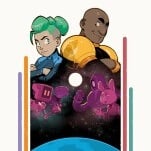Team Up to Beat AI in the 2001: A Space Odyssey Board Game

A one-versus-many game where normal humans are fighting an out-of-control artificial intelligence that will stop at nothing, including murder, to keep itself plugged in? If ever there was a game for our present moment it’s this one… even though it’s based on a movie from 57 years ago.
2001: A Space Odyssey is a constant presence on lists of the greatest movies ever made, coming in as the #1 movie in Sight & Sound’s directors’ poll in 2022 (although it didn’t even get a nomination for the Academy Award for Best Picture, which might be the worst miss among the many bad misses in that award’s history). Designer Phil-Walker Harding has now taken the plot of the central third of the film and created a semi-cooperative board game where one player plays as HAL, the rogue AI that refuses to open the pod bay doors, and two to four other players play as the various astronauts, who try to keep HAL from shutting down the ship while they coordinate to deliver the codes to turn the computer off. It’s a very good interpolation of the film’s best-remembered part—honestly, do you know anyone who talks about the last part when they talk about this movie? You don’t, I promise you—that gets some of the key points in the film right by turning them into core facets of the mechanics.
In 2001, the players are working together, but their communication is always limited and sometimes even prohibited. The players’ shared deck has a number of action cards, including ones to repair the ship’s four main systems, ones to open doors (including those of the pod bay), and ones to retrieve cards from the shared discard pile, but the most important cards are the 12 numbered 1 through 12 that players must use to turn HAL off. One player has to get a sequence of three of those cards, any three as long as they’re consecutive, and deliver them to the Core space on the board to knock HAL down a peg; knock him down three and the players win. You can give a card to another player if you’re on the same space, but just one, and you can never show other players the cards you have.
HAL wins by shutting off the life support system, which requires that that player play seven life support cards, or shutting off the ship’s other three systems, which requires playing four matching cards to each of those spaces. HAL starts with a hand size of six cards, dropping one for each level the players knock HAL down, with three of those hand cards always visible to players. HAL’s cards beyond the damage cards include closing doors (including… you get it), forcing a specific player to choose a card to discard, asking a single player if they have a specific card and then making them discard it, and the annoying Lipread card. When that card is in HAL’s hand and visible to the astronauts, the players can not communicate at all until someone plays a Cancel card.

-

-

-

-

-

-

-

-

-

-

-

-

-

-

-

-

-

-

-



















